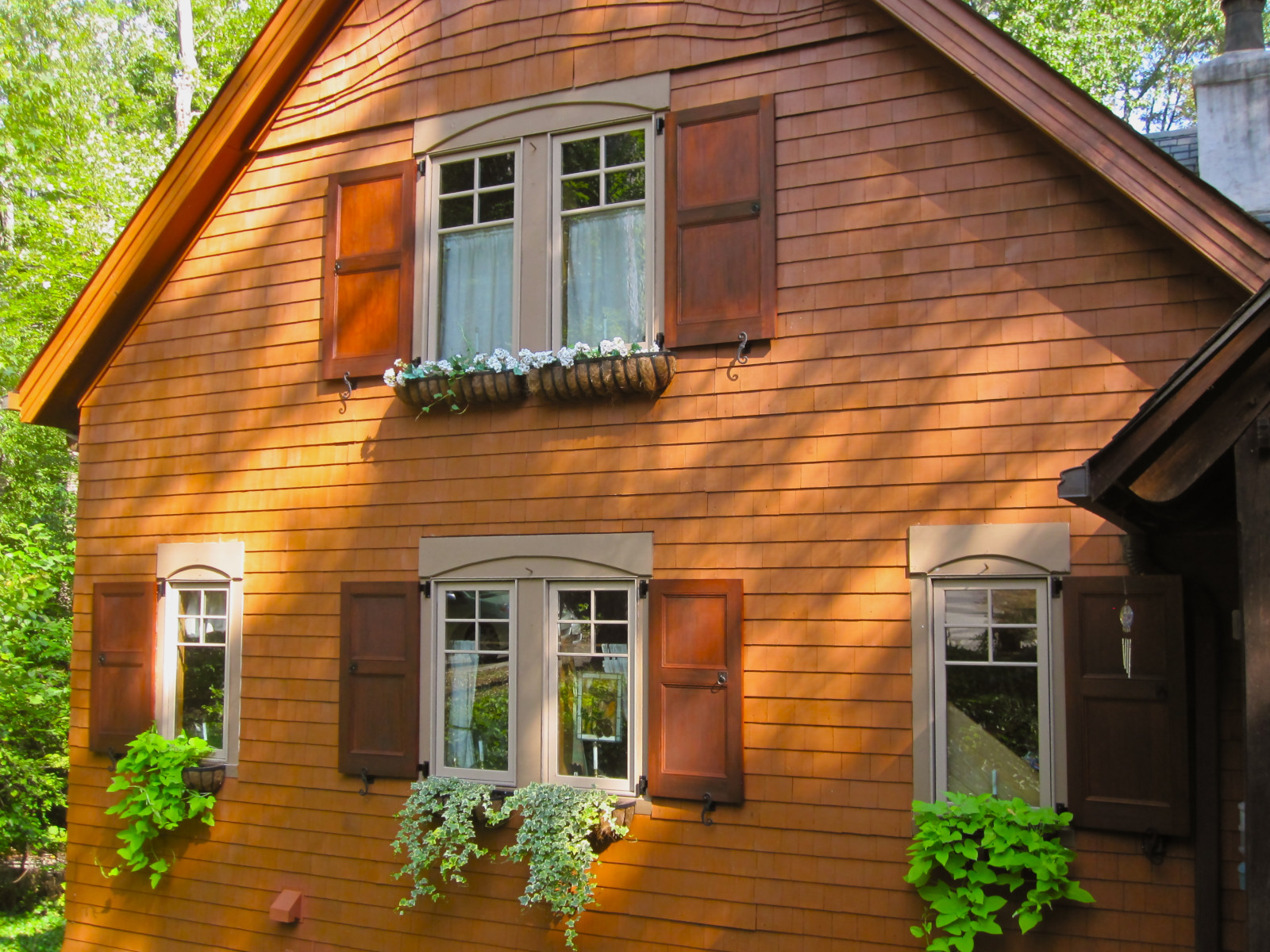
If you want your exterior shutters to be able to open and close properly over your windows, you need to make sure that you choose the correct exterior shutter hardware. This can be a bit confusing as every window and window frame is different. Even if you have the same style of trim on all of your windows don’t be surprised if some of the measurements are slightly different.
Throughout the Fall I will be writing articles on how to choose the correct exterior shutter hardware to make your shutters functional…or simply look functional.
This article will cover the types of hinges that are available. At the bottom of this article is a Summary which has some Quick Reference tables that you can use. If you are already familiar with exterior shutter hardware, feel free to skip directly down to the Summary. You will also find some pictures showing different types of installations.
Types of Exterior Shutter Hinges
| 1. Straight Strap |
2. L Strap |
3. Plate |
4. Mortised |
| |
 |
 |
 |
Exterior shutter hinges can be broken into two groups; surface mounted and edge mounted. Surface mounted hinges are typically installed on the back of the shutters. These can include (1) straight straps, (2) L straps and (3) plate shutter hardware. Bahama shutter hinges (not shown) are also surface mounted but attach at the top front face of the shutters. Surface hinges can mount onto your house with either a plate pintle or with a lag bolt pintle. Edge mounted hinges (4) are mortised into the edge of the exterior shutter closest to the window and look similar to a door hinge.
Closed Position for Your Shutters
| 5. Inside Mount – Window frame shown in Green |
6. Overlap Mount – Shutters overlay opening so no frame is exposed |
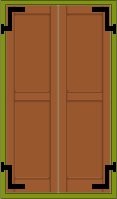 |
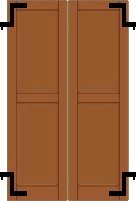 |
The first thing that you need to decide is where the shutters will sit when closed over your window. Exterior shutters can be mounted to fit within your window frame and/or jamb (see diagram 5 above – inside mount) or to completely cover your window frame (see diagram 6 above – overlap mount). Most often shutters are mounted as an inside mount. This is because with an inside mount installation, exterior shutters are seated and secured within the frame when the shutters are closed. More resistance to high winds is achieved because the wind cannot “lift” the shutter off like a kite in the wind. Also, inside mount installations will help prevent break-ins as the shutters cannot be lifted off the hinges when closed properly. The reason you would use an overlap mount is if you were using Bahama shutter hardware or if there was not enough depth for the shutters to sit within the window frame and/or jamb.
Inside Mount for Exterior Shutters (see diagram 5)
If you are using an inside mount take a look at where your shutters will sit within the window opening when closed. You need to know what the material is that will be around your closed shutters. (This is shown in green in diagram 5 above) If this is framed in wood that is deep enough to hold your shutters then you can use either surface mounted hinges or edge mounted hinges. If the opening is a material other than wood, such as brick, vinyl or stone, then you will need to use a surface mounted hinge.
Overlap Mount for Exterior Shutters (see diagram 6)
If your shutters will be overlapping your window opening, so that there is no window frame visible, the most practical option is to use a surface mounted hinge. These can be any strap or plate hinge mounted to the sides or Bahama shutter hinges mounted at the top.
Hinge Mounting Method
If you are using surface mounted exterior shutter hinges you need to decide where you can mount the hinge pintle. This will determine whether you need to use a plate pintle with screws or a lag bolt pintle. If you are able to mount the hinge pintle directly onto the flat surface of your wood trim or wood frame (shown in green in diagram 5) you will be able to use a plate pintle. If you need to mount the hinge pintle onto some other material like brick or stone you will need to use a lag bolt pintle.
Once you know the type of exterior shutter hinge and pintle you will need to determine the offset. This will be covered in next blog post.
Summary / Quick Reference
To help choose the type of hinges you will need to mount your exterior shutters follow these 4 steps.
Step 1. Determine whether you have an inside mount (see diagram 5 above) or an overlap mount (see diagram 6 above).
Step 2. Look at the building material around your window opening and, using Table A below, find out whether you need a surface mounted hinge or an edge mounted hinge.
Step 3. Look at the building material where you will be mounting your hinges and, using Table B below, find out the type of mounting method you will need to use.
Step 4. Using Table C below look for a hinge that meets your requirements for hinge type (step 2) and for mounting method (step 3). You can see the available hinges pictured above (pictures 1,2,3 and 4) to help decide the look you want.
Hinge Type – Table A
Use this table for quick reference for determining hinge type
| Closed Position | Material Around Opening | Hinge Type to Use |
| Inside Mount | Wood | Surface or edge mounted |
| Inside Mount | Brick | Surface mounted |
| Inside Mount | Stone | Surface mounted |
| Inside Mount | Vinyl | Surface mounted |
| Inside Mount | Stucco or other veneer | Surface mounted |
| Outside Mount | Any | Surface mounted |
Hinge Mount – Table B
Use this table for quick reference for to determine the type of pintle to use with your surface mounted hinges
| Material Pintles Are to be Mounted To | Use This Pintle |
| Wood (flat surface) | Plate Pintle with screws |
| Wood (non-flat surface) | Lag Bolt Pintle |
| Brick | Lag Bolt Pintle |
| Stone | Lag Bolt Pintle |
| Vinyl | Lag Bolt Pintle |
| Stucco or other veneer | Lag Bolt Pintle |
Available Hinges – Table C
This next table will list different hinges and the mounts available.
| Hinge Type | Item Codes | Available Mounts |
| Edge Mounted |
HE1-401 | Edge Mounted |
| HE1-405 | Edge Mounted | |
| HE3-370 | Edge Mounted | |
| Straight Strap | HE1-701 | Plate Pintle with screws OR Lag Bolt Pintle |
| HE1-702 | Plate Pintle with screws OR Lag Bolt Pintle |
|
| HE1-705 | Plate Pintle with screws OR Lag Bolt Pintle |
|
| HE2-10 | Plate Pintle with screws OR Lag Bolt Pintle |
|
| HE6-4000 | Plate Pintle with screws OR Lag Bolt Pintle |
|
| L Strap | HE2-40 | Plate Pintle with screws OR Lag Bolt Pintle |
| HE6-2000 | Plate Pintle with screws OR Lag Bolt Pintle |
|
| Plate | HE3-321 | Plate Pintle with screws |
| HE3-323 | Plate Pintle with screws | |
| HE5-670 | Plate Pintle with screws |
Mounting Examples
The following photos show some different mounting methods used on different buildings.
 Pennsylvania – Stucco face – inside mount – wood frame – surface mounted plate pintle with screws.
Pennsylvania – Stucco face – inside mount – wood frame – surface mounted plate pintle with screws.
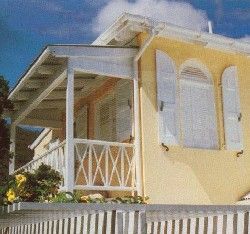 St. Croix USVI – Stucco face – inside mount – no frame – lag bolt pintle mounted through the stucco.
St. Croix USVI – Stucco face – inside mount – no frame – lag bolt pintle mounted through the stucco.
 California – Concrete face – overlap mount – surface mounted Bahama shutter hardware
California – Concrete face – overlap mount – surface mounted Bahama shutter hardware
 Belgium – Stone face – inside mount – stone window frame – lag bolt pintles
Belgium – Stone face – inside mount – stone window frame – lag bolt pintles
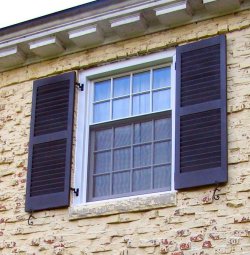 West Virginia – Stucco over brick face – inside mount – wood frame – surface mounted plate pintles with screws.
West Virginia – Stucco over brick face – inside mount – wood frame – surface mounted plate pintles with screws.

A naturally beautiful and renewable choice – Wood shutters and doors by
Kestrel Shutters & Doors, Inc. www.DIYShutters.com 1-800-494-4321 / sales@diyshutters.com
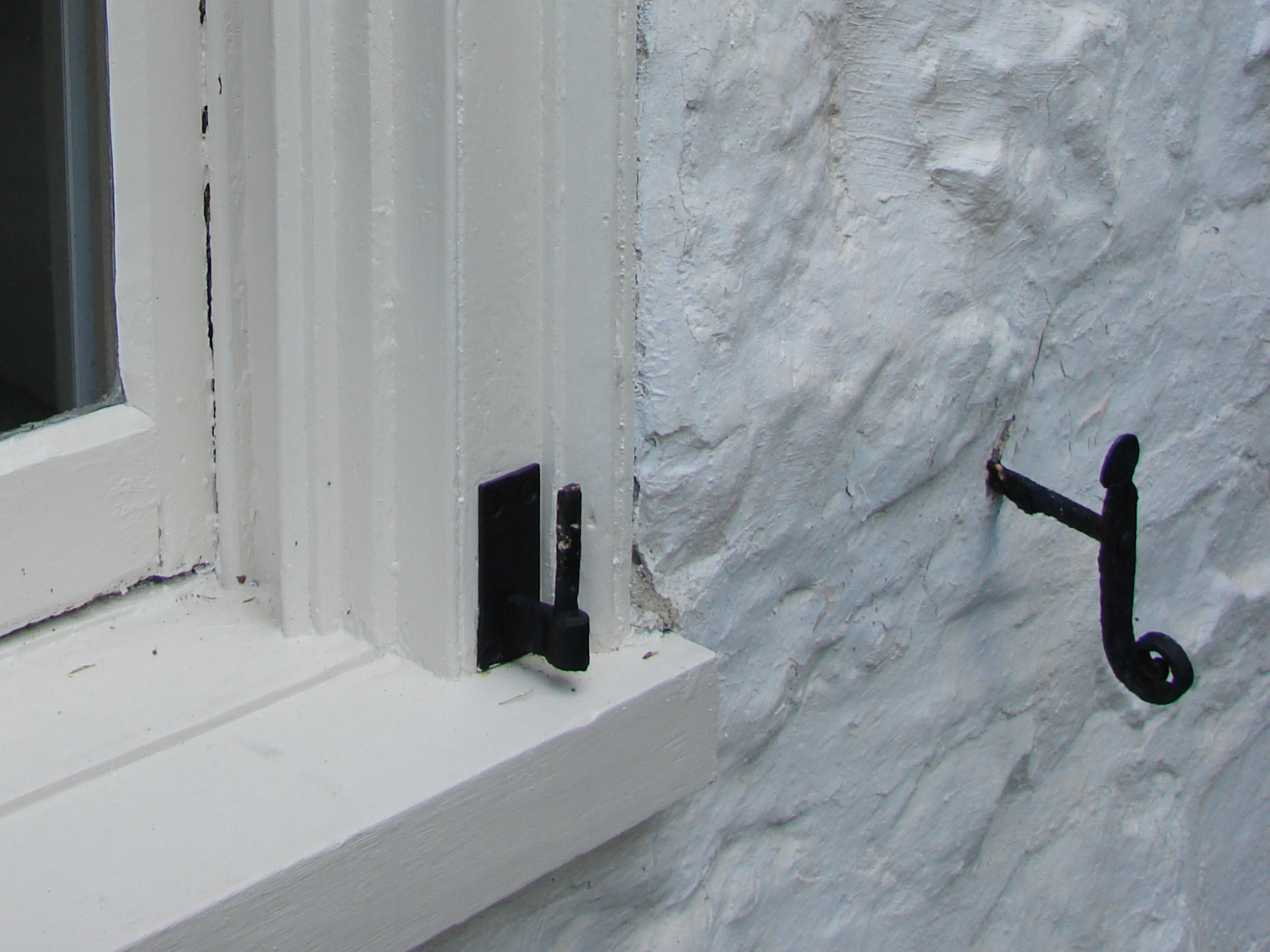
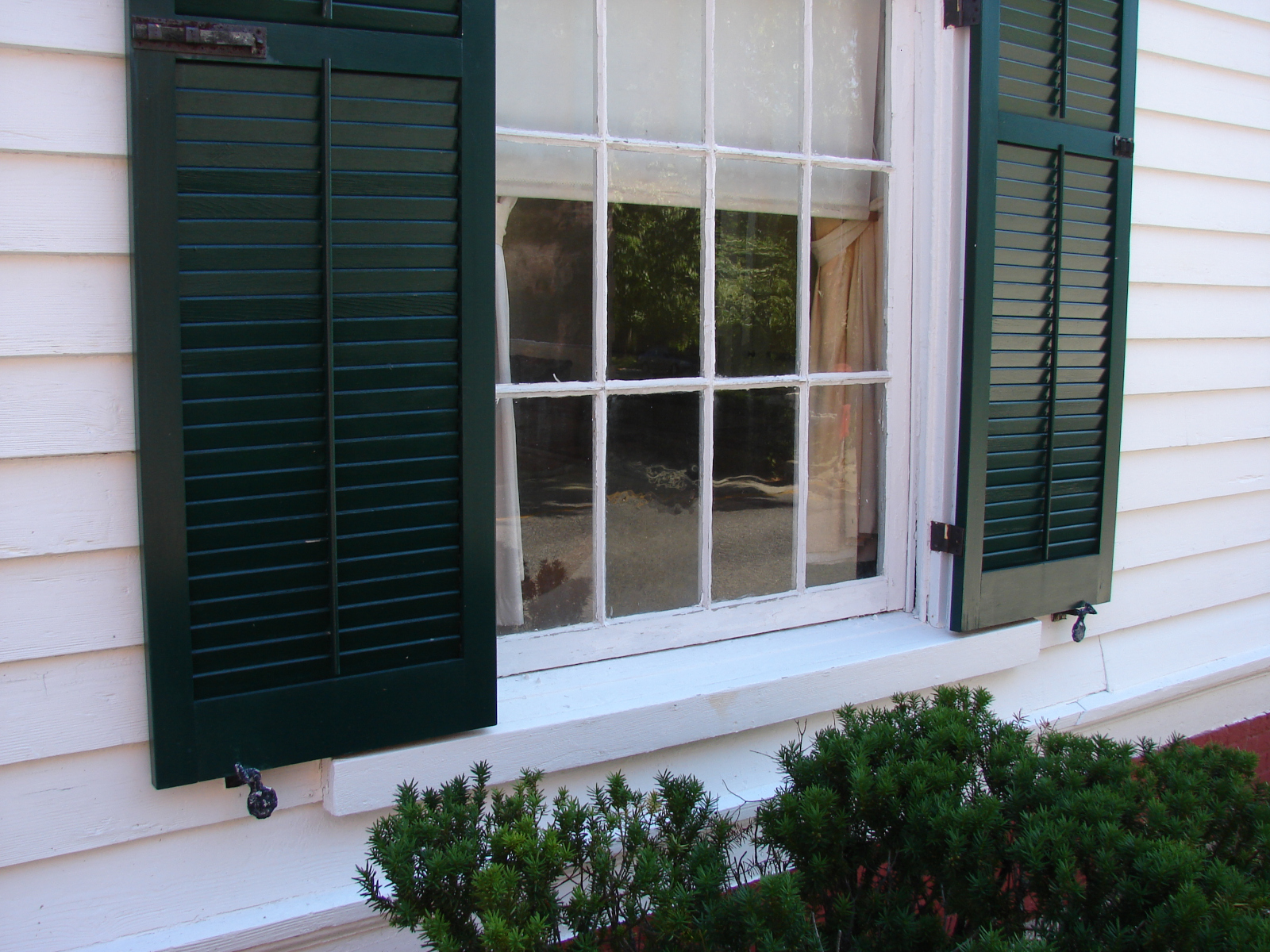
My cousin recommended this blog and she was totally right keep up the fantastic work!
Do you have faux hinges?
Hello Jerry,
Yes we do have faux hinges. Here is the link: http://www.diyshutters.com/plasticshutterhardware.htm
The faux hinges we offer were designed by a restoration architect and are meant to appear as if your shutters were functional and not decorative only. We also offer faux shutter dogs, ring pulls and slide bolts all made here in Pennsylvania.
I hope this helps. If you should have any other questions please let me know.
Jim
I would like to mound New York style L hinges on shutters where I can see them when open. I think this is not “blind” and don’t know if I need special hardware to do this.
Hi Mr Grover,
You can mount the New York “L” hinges upside down so that they are attached to the front face of the shutters when they are open. However, if the shutters will be functional, so that they can open and close fully, you need to make sure that you have enough depth within the window for the shutters. If the shutters are for decorative use only you would not need any special hardware.
I hope this helps ! Please let us know if you have any other questions.
Jim
Can you choose any shutter and add hardware to make them functioning? We are in the early stages of wanting to add shutters to our colonial exterior, but I don’t want the fixed look (thought we would probably never actually close the shutter – I just prefer the look).
Curious if we can purchase any kind of shutter and the add the appropriate hardware to make them functioning?
Thanks!
Hi Jo,
Any style of shutter can be made functional. It is rare that the shutter hardware is not appropriate for the shutter. Exceptions would be if the shutter hardware does not work with the particular shutter material ( Aluminum, homemade shutters from plywood… ) or shutter thickness. Where you tend to run into limitations is where the shutter hardware cannot be mounted properly to the window/door frame or surrounding area. If you are not sure which shutter hardware will work for you, feel free to email us a couple of photos ( some of the overall windows and some more close up ) and tell us what you are looking to do with the shutters. From that we can get started with sorting some options for you. – Jim